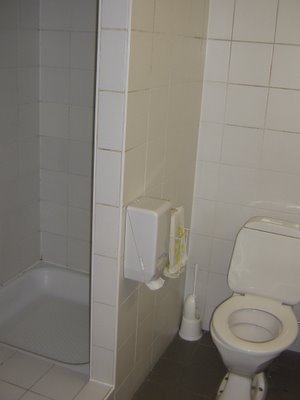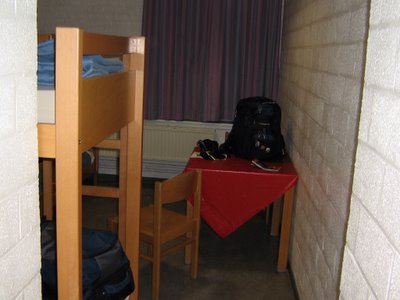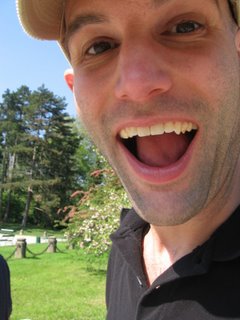Pictures from 2006 Ghent IP, Part 3B (or: Brugge:Lace, Blood, and Chocolate)
After we looked at the depressing Our Lady's Church, it was time for some good ol’ consumerism: shopping. I desperately needed a chocolate fix, and Sarah needed some gifts for friends & family back home. We found a chocolate shop with superb chocolates and sub-par service, but good lace was trickier to find. After checking several shops, we happened upon the most talkative shop keeper I’ve seen yet. More impressive, he was trained by nuns in Brugge at the now defunct lace making school. Going to lace making school ensured that he was the only boy in a class of all girls (woo hoo!). The disadvantage is that he was teased constantly by them. Oh, girls can be so cruel! Fortunately, he survived, and demonstrated his lace-making skills for us:
 There he is working on one of his creations. Sarah is looking in awe while Kerry is taking a movie. His hands moved so quickly. Here’s a close-up:
There he is working on one of his creations. Sarah is looking in awe while Kerry is taking a movie. His hands moved so quickly. Here’s a close-up: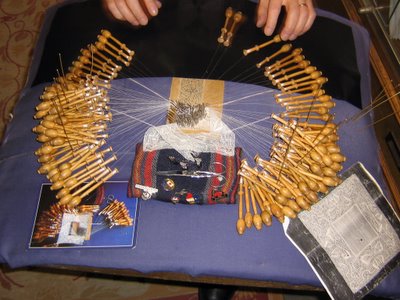 Each one of those wooden dowels is a bobbin of thread that must not be confused with any of the other bobbins. And look at all those pins!
Each one of those wooden dowels is a bobbin of thread that must not be confused with any of the other bobbins. And look at all those pins!Now for the blood part of the title: There is a church in Brugge called the Chapel of the Holy Blood. It contains a religious relic, a rock crystal bottle purported to have Jesus’ blood in it. This fascinated me, especially in light of modern genetic technology. We could analyze the DNA of Jesus! We could clone him! We could find out if he was predisposed to obesity! I’ll stop blaspheming and get on with the story.
When we arrived in the church, a priest was standing next to the altar reading in several languages a story about the blood, and how the faithful are allowed to venerate it. Another priest sat behind an altar with this gold-capped glass tube in front of him. Here is the best image I have of the relic:
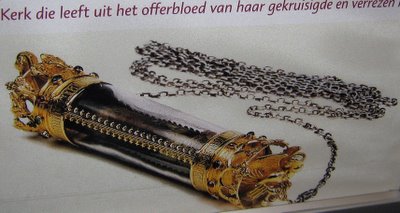 Since I didn’t want to disrespect the Church of the Holy Blood with my camera, that photo is a picture of a picture outside the church. The church was very solemn and quiet, and there weren’t many tourists inside, since the church had just opened for the day. Kerry, Sarah, and I whispered to each other to find out who was going to venerate the relic.
Since I didn’t want to disrespect the Church of the Holy Blood with my camera, that photo is a picture of a picture outside the church. The church was very solemn and quiet, and there weren’t many tourists inside, since the church had just opened for the day. Kerry, Sarah, and I whispered to each other to find out who was going to venerate the relic.First off, to “venerate” the relic, you had to wait in line behind others. Venerating really just meant standing in front of the relic, however you were allowed to touch it with both hands. As I stood in line, a large sign informed me in several languages that I must show respect for the relic. I had already taken off my coat, hat and backpack, so I was about as presentable as I was gonna get for touching Jesus’ blood. As the line moved and I got closer to the relic, there was a coin box for donations. I figured that I should probably give them some money for their troubles, so I dropped in a few coins, less than a Euro total. The line moved, and I shuffled closer to the relic. Each time a person finished venerating the relic, the priest sitting behind the altar would wipe it off with a small white cloth. Then the next person would take their place in front of the relic, and the process repeated. I didn’t really believe that what I was about to do had any religious or spiritual significance, but I find the idea of relics interesting. And, if it turned to really be Jesus’ blood, I wanted to be able to say “I touched it”. It’s like saying you’ve been to Mount Rushmore or something.
It was my turn. I had been watching the people in front of me to see where they placed their hands, how long they spent touching it, and what they did afterwards. I decided to go with a two handed touch, about 5 seconds long, and cross myself afterwards. Yes, I crossed myself, and it didn’t really feel right since I’m not Catholic. However, I was in a Catholic church, touching a religious relic, and I didn’t want to be disrespectful towards anyone’s beliefs. Besides, venerating a religious relic isn’t a sacrament in the Catholic church, so I wasn’t invading those tricky beliefs.
While looking for some links for this blog post, I found this one, which says that the relic probably isn’t Jesus’ blood at all, but a perfume bottle that came from Turkey in the 11th or 12th century. This leads to all sorts of other questions, such as: if the relic is false, why is it still on display?
This church was incredibly ornate, and I wish we had spent more time in it. Wandering around while people were venerating the relic didn’t feel quite right, though, so we left. On our way out, we ran into Alex and Sara, two students in the Intensive Program from Germany. We waited for them to finish in the church, and then headed over to the Belfry, my favorite part of the visit to Brugge. That post will have to wait, however. I need to get some breakfast! Read more!

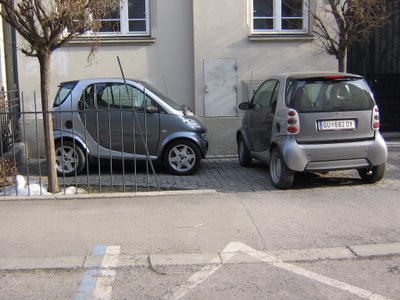 These are called
These are called  There were the steps leading up to the mighty Schlossberg. But alas, it wasn’t meant to be today. The Schlossberg was closed for the winter. I will have to wait a couple of months.
There were the steps leading up to the mighty Schlossberg. But alas, it wasn’t meant to be today. The Schlossberg was closed for the winter. I will have to wait a couple of months. This is basically a man-made island in the middle of the river Mur. Very funky looking and it contains a café, an amphitheater, and playground. Elisabeth and I talked about coming back later in the day to have a coffee there, but never did.
This is basically a man-made island in the middle of the river Mur. Very funky looking and it contains a café, an amphitheater, and playground. Elisabeth and I talked about coming back later in the day to have a coffee there, but never did. This photo is too far away to do it justice. All you can see are the odd protrusions coming out of the roof in the background. Click on the link above my photo for some professional photography of the building. This futuristic looking building has been nicknamed the “friendly alien”, and houses the art collection for the city of Graz.
This photo is too far away to do it justice. All you can see are the odd protrusions coming out of the roof in the background. Click on the link above my photo for some professional photography of the building. This futuristic looking building has been nicknamed the “friendly alien”, and houses the art collection for the city of Graz. Note the tangle of wires overhead. Looking back, it seems pretty obvious to call them trams...
Note the tangle of wires overhead. Looking back, it seems pretty obvious to call them trams... You can see the excitement in their eyes. We were going to Brugge! After hopping a tram, then a train, and riding for about 20 minutes, we arrived in the Brugge train station and began to walk towards the city center. The first place we headed was Our Lady's Church, which has an amazingly high tower, 122 meters high I'm
You can see the excitement in their eyes. We were going to Brugge! After hopping a tram, then a train, and riding for about 20 minutes, we arrived in the Brugge train station and began to walk towards the city center. The first place we headed was Our Lady's Church, which has an amazingly high tower, 122 meters high I'm  Please note also that the church tower is not actually leaning. I am an idiot when it comes to basic photograph composition.
Please note also that the church tower is not actually leaning. I am an idiot when it comes to basic photograph composition.
 And then we went in:
And then we went in: 
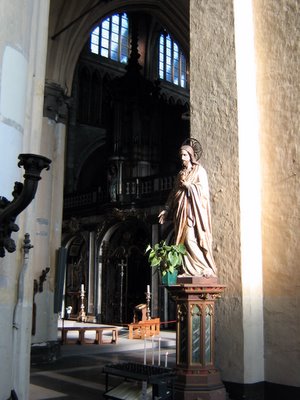 This was a beautiful church, like the others I saw in Ghent, but for some reason I found it depressing. Kerry told me I must have been feeling melancholy that day, and he was probably right. I thought the church was beautiful, but the fact that it was (slowly) crumbling into a pile of rocks made me wonder what all the effort to build it was for. Granted, this crumbling is happening over a period of hundreds of years, so I don't know what my problem was. This church has lasted longer than most structures in the United States. I think the next picture shows the decaying beauty of the church:
This was a beautiful church, like the others I saw in Ghent, but for some reason I found it depressing. Kerry told me I must have been feeling melancholy that day, and he was probably right. I thought the church was beautiful, but the fact that it was (slowly) crumbling into a pile of rocks made me wonder what all the effort to build it was for. Granted, this crumbling is happening over a period of hundreds of years, so I don't know what my problem was. This church has lasted longer than most structures in the United States. I think the next picture shows the decaying beauty of the church:  After we finished at the church, we roamed around the town looking for chocolates and Belgian lace. I should point out that Sarah was looking for Belgian lace. I was only looking for chocolates. I will continue this saga in another post. It's time for supper!
After we finished at the church, we roamed around the town looking for chocolates and Belgian lace. I should point out that Sarah was looking for Belgian lace. I was only looking for chocolates. I will continue this saga in another post. It's time for supper!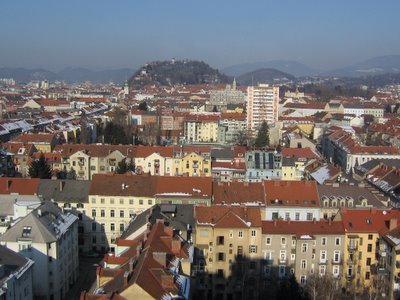
 The talking, listening, and sharing of ideas increased quickly. Here is Matthieu pausing from a lively conversation to look into the camera, while Aga looks into the distance, lost in thought:
The talking, listening, and sharing of ideas increased quickly. Here is Matthieu pausing from a lively conversation to look into the camera, while Aga looks into the distance, lost in thought: The turnout was tremendous, and many students met each other and talked, having only exchanged awkward glances before. Here two Lithuanian students, Egle and Vida, pause to smile for a photo:
The turnout was tremendous, and many students met each other and talked, having only exchanged awkward glances before. Here two Lithuanian students, Egle and Vida, pause to smile for a photo: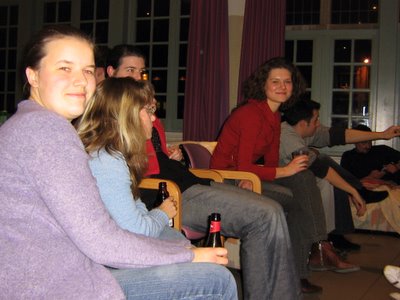 There were so many students in the lounge that seating was limited. In this photo, Kerry from the U.S. sits in a small chair in the center of the circle. He is clearly enjoying his fine Belgian beer:
There were so many students in the lounge that seating was limited. In this photo, Kerry from the U.S. sits in a small chair in the center of the circle. He is clearly enjoying his fine Belgian beer: Students from the U.S. displayed their ability to look and smile in unison at a camera. Some are even holding up their drinks as if to toast the successful evening:
Students from the U.S. displayed their ability to look and smile in unison at a camera. Some are even holding up their drinks as if to toast the successful evening: After some time, it was suggested that the party move to a louder and darker location (aka, to go dancing). The group of students left the hostel, and made the most of the night. I have no photos of this, but if somebody has some they'd like to share, feel free to e-mail them to me.
After some time, it was suggested that the party move to a louder and darker location (aka, to go dancing). The group of students left the hostel, and made the most of the night. I have no photos of this, but if somebody has some they'd like to share, feel free to e-mail them to me.

 As an American who sees only semi-old and ultra-new buildings in the U.S., what often blew me away in Ghent was the juxtaposition of the really really old building and city design with the new (and corporate) influences surrounding it. Check this next photo of the same church, but with the McDonald's on the other side of the street, and Het Belfort (The Belfry) in the background:
As an American who sees only semi-old and ultra-new buildings in the U.S., what often blew me away in Ghent was the juxtaposition of the really really old building and city design with the new (and corporate) influences surrounding it. Check this next photo of the same church, but with the McDonald's on the other side of the street, and Het Belfort (The Belfry) in the background: To set the scene a bit more, here is another photo taken from the same location as the last two, but looking down the street that Sint Niklaaskerk stands in front of. This open area where all the tents are set up is called Koren Markt:
To set the scene a bit more, here is another photo taken from the same location as the last two, but looking down the street that Sint Niklaaskerk stands in front of. This open area where all the tents are set up is called Koren Markt: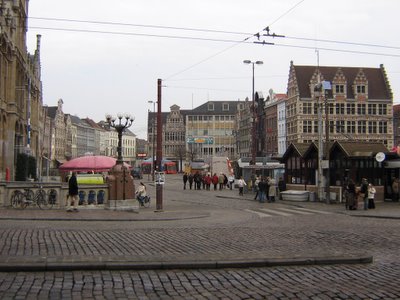 Finally, I'll show two pictures from the inside of Sint Niklaaskerk. I don't know much about its history or design, so I won't even bother to comment on whether the architecture is Neo-Luddite or Post-Stupidism. It was the first of several large, old cathedrals I saw while in Belgium, and for some reason I find them fascinating, and also a bit depressing. First, an attempt to capture the entire altar in one picture:
Finally, I'll show two pictures from the inside of Sint Niklaaskerk. I don't know much about its history or design, so I won't even bother to comment on whether the architecture is Neo-Luddite or Post-Stupidism. It was the first of several large, old cathedrals I saw while in Belgium, and for some reason I find them fascinating, and also a bit depressing. First, an attempt to capture the entire altar in one picture: Next, a shot of a big pulpit that stood on the right side of the main worship area, about halfway down the row of pews. It seemed strange to me to put the preacher way high above the people, and also behind some of them, where he couldn't be seen. But at the same time, if you want to give a good fire and brimstone sermon to scare the crap out of people, this would be the place to do it. I saw this same layout in other cathedrals as well, so I'm sure there is a specific reason for it:
Next, a shot of a big pulpit that stood on the right side of the main worship area, about halfway down the row of pews. It seemed strange to me to put the preacher way high above the people, and also behind some of them, where he couldn't be seen. But at the same time, if you want to give a good fire and brimstone sermon to scare the crap out of people, this would be the place to do it. I saw this same layout in other cathedrals as well, so I'm sure there is a specific reason for it:


